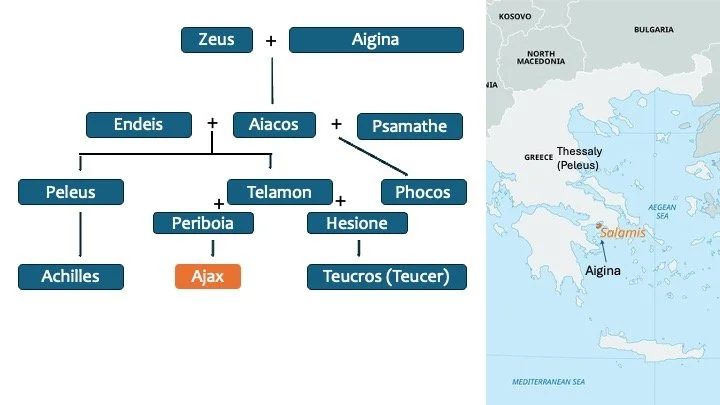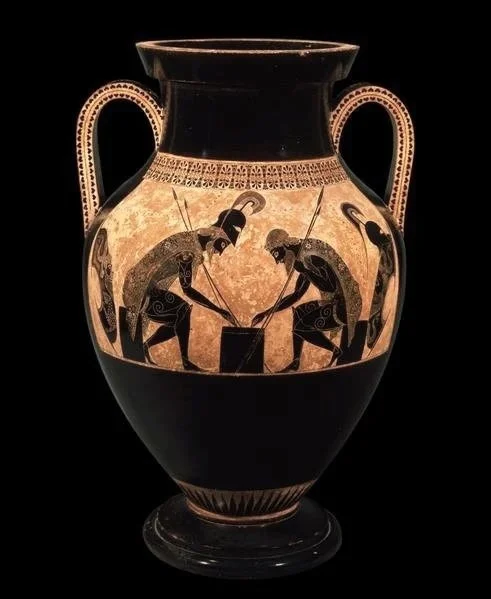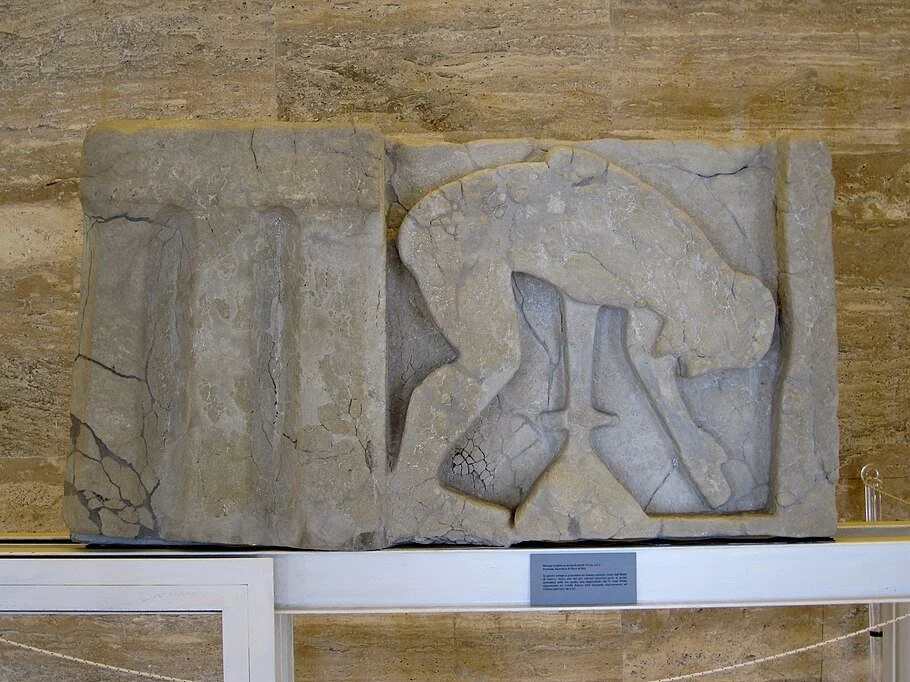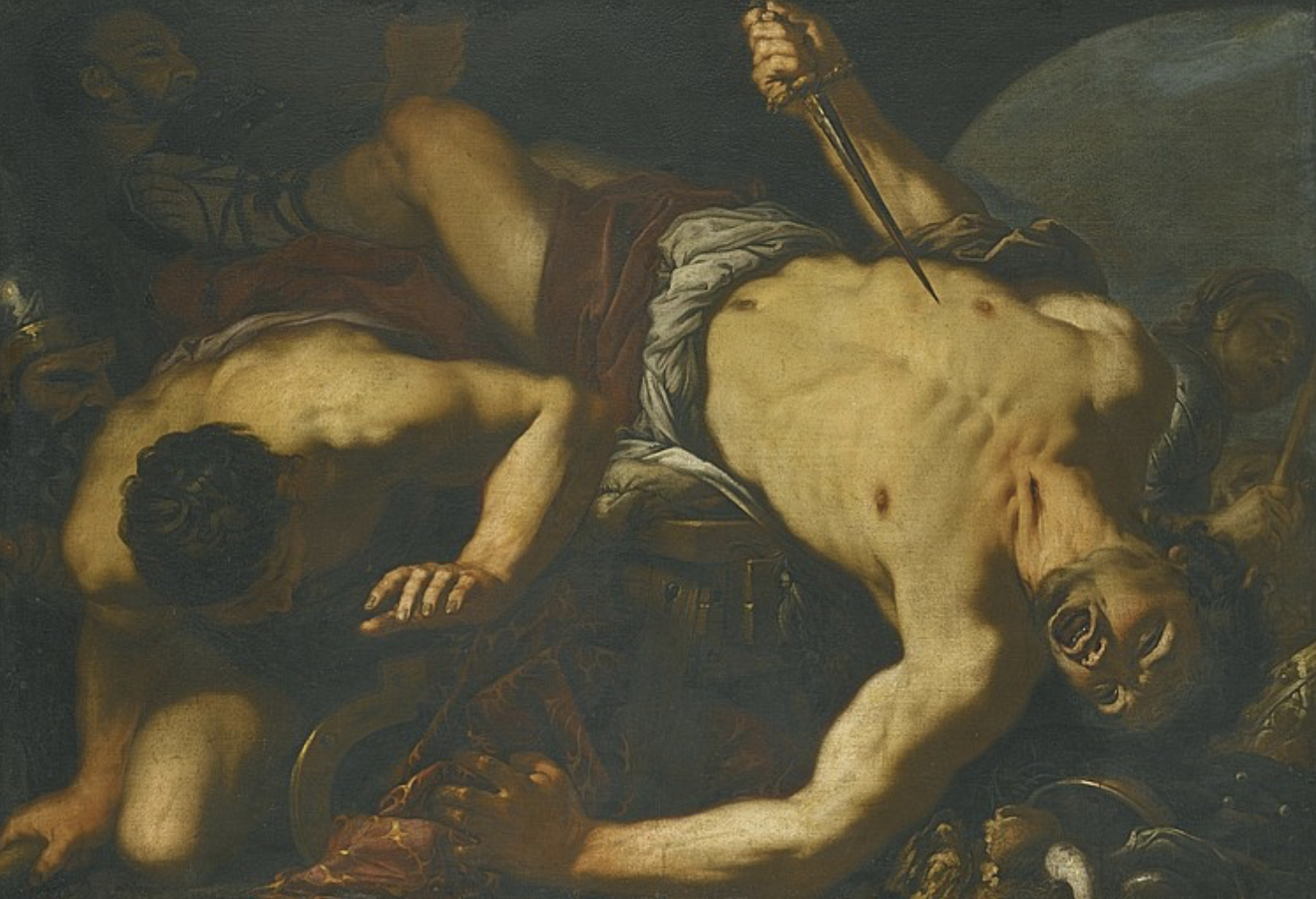Episode 28: Ajax the Greater: Greatness and Depression
Welcome to another edition of the Greek Myth Files! In this episode, written by an honors student at the University of New Hampshire (Laura Hills), we explore the life and times of Ajax “the Greater,” Achilles’ cousin and something like the second strongest warrior on the Greek side of the Trojan War. His end is truly tragic, especially as it comes after a series of doughty (mighty) deeds!
To aid in understanding the somewhat complicated genealogy, we’ve produced a family tree for you, with a map to show Ajax’s origin (Salamis).
Ajax was Achilles’ cousin and they shared a lot in common. Both were strong and outstanding warriors, and they both would die in Troy. We have only a few images of the two together in the Trojan War, the most famous being the Exekias Vase showing the two of them enjoying a down moment in the war where they could relax and play a game! Exekias seems to have preferred the calmer moments in between mythical actions (see the suicide of Ajax below).
The next episode with the two heroes occurs when Achilles is killed by the Trojan hero Paris (ok, with a little bit of help from the god Apollo). There was a huge fight over the body and arms of Achilles, and both Ajax and Odysseus took part in helping save both the arms and the body from the Trojans. In one of the most famous images of Achilles’ death, we see that Ajax looms large over protecting his cousin’s body.
Ajax (spelled in Greek AIAS) stands to the left over Achilles’ body, killing Glaukos. Athena stands to the left of Ajax, currently assisting Ajax (but later will favor Odysseus over him). To the right of Glaukos is Paris, who had delivered the killing blow (to the foot? or the side?) to Achilles. Aineias, later founder of the Roman people, is to Paris’ right. Color replica by Kathleen Vail of a black-and-white drawing of a now lost (!) Chalcidian vase from around 540 BC.
The suicide of Ajax after killing a bunch of livestock is commonly depicted on vases and temple sculpture. Most show Ajax after he has killed himself. Here is a selection of images from the ancient world, from the earliest to the latest.
An illustration (by Wikipedia artist Perhelion) of Suicide of Ajax on the so-called Eurytios Crater, found in a tomb in Cerveteri (Italy) and dating from around 600 BC. The three names (in Corinthian script) are “Diomedes” (left), “Odysseus” (right), and Ae-was or Aias (below). Probably the earliest depiction of the death. Now in the Louvre.
Ajax’s suicide as found on a Corinthian vase from around 580 BC. Greek heroes (like Odysseus, Diomedes, Teucros and other) surround the dead hero, who is far larger than the living figures—emphasizing Ajax’s size and strength. Now housed in the Basel Antikenmuseum.
Terracotta sculpture on an altar, perhaps from the city of Gela (Sicily), around 530 BC, now housed in the Ny Carlsberg Glyptotek in Copenhagen.
Tecmessa, Ajax’s concubine in Troy, places a shroud over the dead Ajax, impaled in the back by the sword. Tecmessa will feature heavily in the (much later) play by Sophocles, Ajax. (The Brygos Painter, ca. 490 BC, housed in the Getty Museum)
Ajax commiting suicide, here showing the sword piercing underneath the armpit and emerging from his left shoulder, perhaps hinting at the tradition that Ajax became invunlerable except for his armpit when Heracles threw his lion skin over him when he was an infant. Early 4th century Etruscan-made krater from Etruria (Italy), now in the British Museum.
Perhaps the most precious image from the ancient world does not show Ajax actually committing suicide, but depicts the moments leading up to it. In this next vase, a famous vase from the outstanding ancient artist Exekias (around 530 BC), shows Ajax planting the sword in the sand. Viewers have to fill in for themselves the subsequent action.
Ajax plants the sword in preparation of his suicide, a vase painted by Exekias, from around 530 BC, now housed in the Chateau-Musée Boulogne-sur-Mer.
This is truly an exceptional take on the myth and nothing else like it is found in antiquity. As the eminent art historian, H. A. Shapiro writes (Myth into Art: Poet and Painter in Classical Greece [Routledge, London and New York 1994] 151–152):
It is rare in this early phase of western art that we sense a real sympathy between artist and subject, verging on a feeling of identification. It is equally astonishing that Exekias has captured so much of the ethos of Sophocles’ play a full century in advance: the loneliness of the solitary act by the barren shore; the methodical behavior of the hero, not at all the actions of a madman; and his troubled demeanor (indicated by lines incised on brow and cheeks), as he broods upon a fate over which he feels he has no control. Much could be said about the masterful composition of the scene: the helmet propped on the big Boeotian shield, giving the impression of a ghostly onlooker (or even Ajax himself, in his former life as the great battle hero); orthe palm tree that “wilts in sympathy” (Hurwitt 1982). Exekias has created a psychological study that stands virtually alone in Archaic Greek narrative art.
Perhaps surprisingly, the suicide of Ajax was not a terribly popular subject in the Renaissance or Baroque periods, so there are not a lot of paintings of the image. The Baroque artist Antonio Zanchi apparently did a large-scale painting (perhaps around 1660), but it’s been held in a private estate until it appeared on sale on Sotheby’s website. We reproduce it here since it is dramatic and disorienting:
Credits:
Script: Laura Hills, University of New Hampshire Honors Student
Narrated: R. Scott Smith
Images and Text for Website: Laura Hills and R. Scott Smith
Voice Actor: Jackson Scheele
Sound Engineer: Jackson Scheele
Music: Jared Sims











